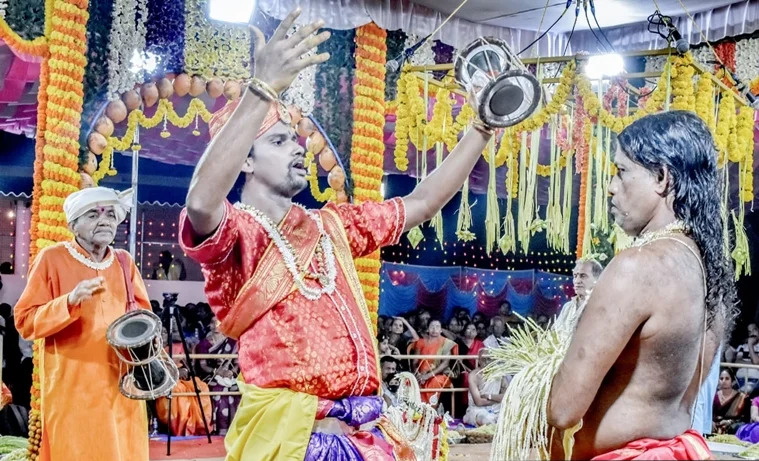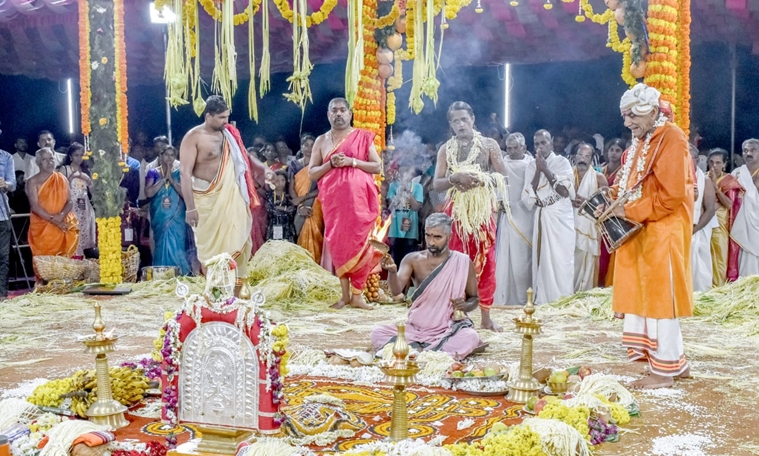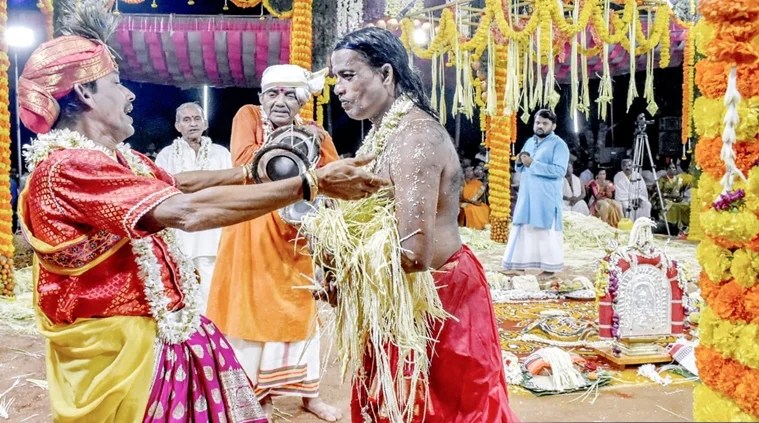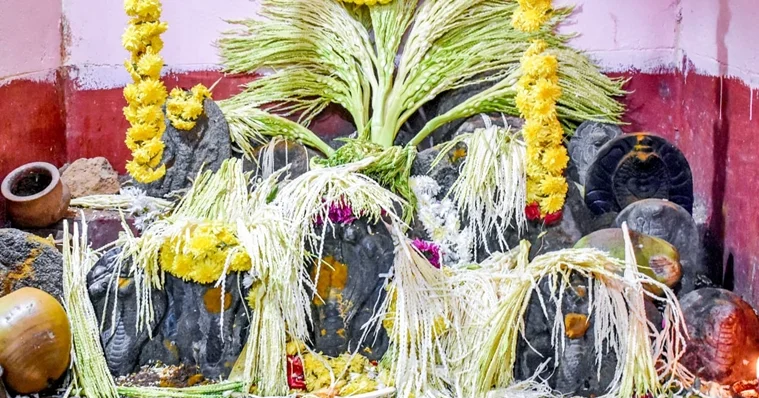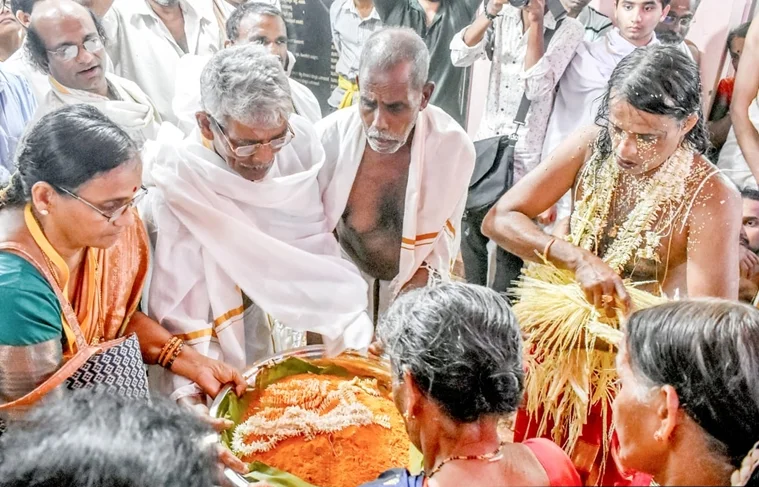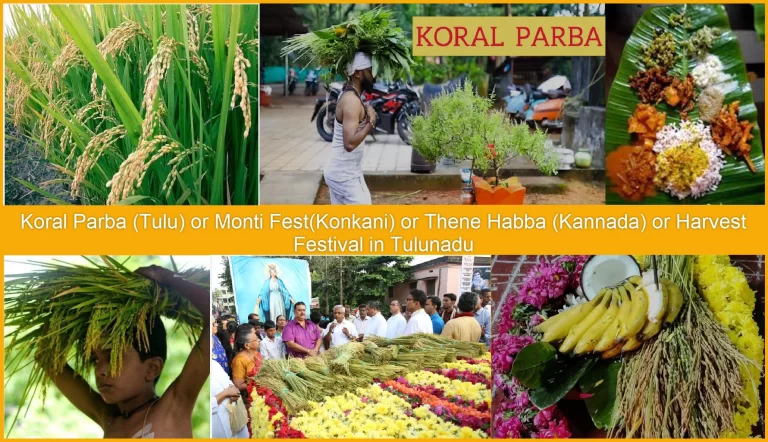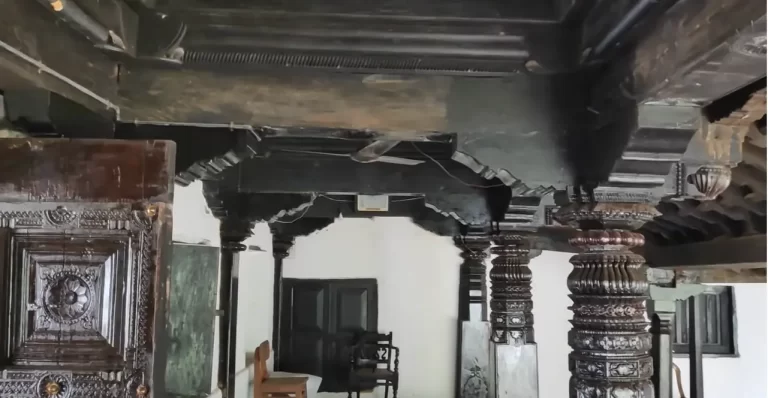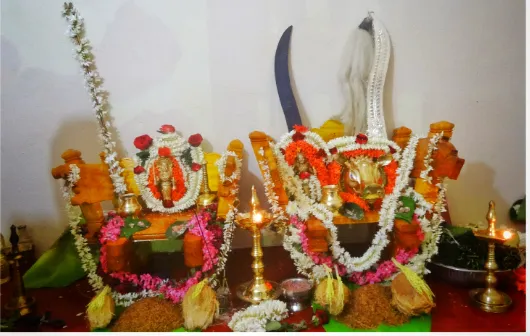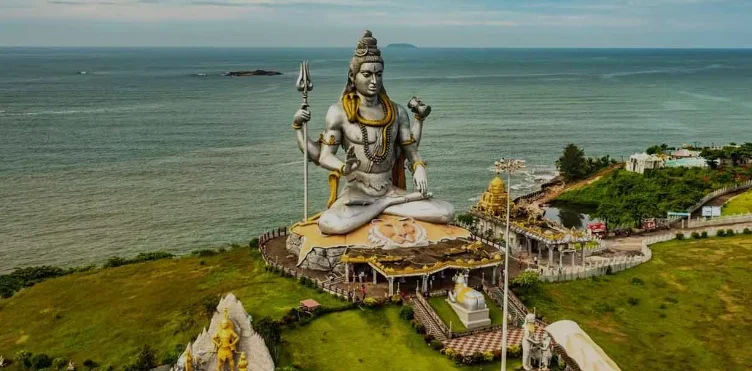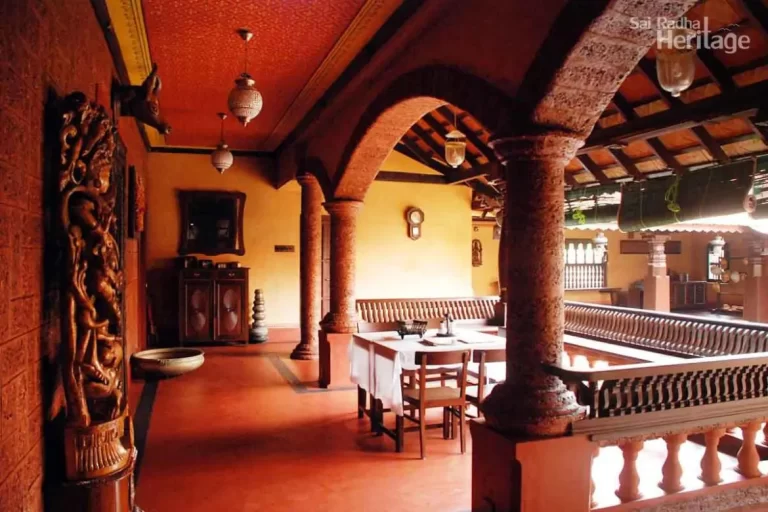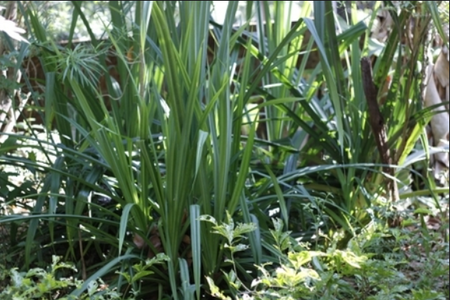Nagamandala
What is Nagamandala
Nagamandala also referred to as Nagaradhane is a multi-day festival and worship program in honor of the snake or serpent god. Coastal Karnataka, situated close to the Western Ghats, is home to many rituals which include worshipping the ecology and species that are a part of it. Nagamandala is one such tradition.
How Nagamandala is Performed
Also known as Nagaradhane, Nagamandala is a multi-day festival in honor of the snake god. During the festival, locals worship Cobra snakes, called Naga devaru, and also perform other rituals in Dakshina Kannada and Udupi region.
Though it is believed that serpent worshippers from north India introduced the festival to the southern part of the country, over the years, Nagamandala has become an integral part of coastal Karnataka as it is home to several snakes, including Cobras.
The ritual is conducted in an extravagant manner throughout the night, wherein dancers, known as the Vaidyas, dress themselves as nagakannikas. The Vaidyas cavort around an elaborate serpent design, drawn with natural colors, in front of the holy shrine.
The Nagamandala ritual is often centered around Nagabana, or snake homes, inside local farms and forests where snakes build their nests. People worship and pay their offerings to the idols of Naga devaru.
Nagamandala depicts the act of divine union of male and female serpents which the performers represent through their acts. Traditionally, two priests are involved in the ritual. One priest dresses like a male serpent, called Naga Patri, who inhales the areca flower extracts, while the other priest dresses like a female serpent, called Naga Kannike, and sings and dances around the serpent design.
The act is complemented by the playing of dakke (an hour glass-shaped instrument), taal (a pair of clash cymbals) and nagaswaram (a double reed wind instrument), and the ritual goes on till the break of dawn.
Nagamandala also involves feeding thousands of people who come from nearby villages. The native villagers support these visiting families by donating ‘hore-kanike’, which consists of rice, vegetables, jaggery and Singar Huvu, the areca flower.
The ritual is a feast to the eyes as it involves music, dance, and chanting of mantras. Most Nagamandala programs are held with support of a local sponsor, since huge costs are involved in organizing the ritual. However, the ritual is fading away owing to the real-estate mafias as they look to build properties on the lands where Nagabanas are found.
People of Dakshina Kannada perform an elaborate ritual called Nagamandala to appease the serpent spirit. It is conducted in an extravagant manner throughout the night, wherein dancers known as the Vaidyas dress themselves as nagakannikas and dance the night away. The Vaidyas cavort around an elaborate serpent design drawn with natural colors on the sacred ground in a pandal, specially erected in front of the shrine. This nocturnal ritual is performed between December and April.
Nagabana
Nagamandala ritual is often centered around Nagabana, of snake homes, location inside local farms and forests where snakes build their nests.
The ritual: Nagamandala ritual celebrates the union of male and female snakes. Rituals are performed by two priests, one enacts male snake while the other female snake. Ritual involves rigorous dances and moves. Some of the rituals continue till early morning hours.
Decorations
Areas around Nagabana are extensively decorated with natural colors and designs. A ‘chappara’ or temporary roof made of coconut leaves is often laid to give some respite from intense heat.
Most Nagamandala programs are held with support of a local sponsor. Program runs for several days and involves feeding thousands of guests each day, hence is deemed an expensive affair.
Where to witness Nagamandala
Nagamandala program details are advertised in local media. When in coastal Karnataka, scan local newspapers for any upcoming Nagamandala program or take help from your host. Nagamandala is open to all and all visitors are served with meals and prasada.
Nagaradhane
Nagaradhane is a form of serpent worship which, along with Bhuta Kola, is one of the unique traditions prevalent in coastal districts of Dakshina Kannada, Udupi and Kasaragod collectively known as Tulu Nadu, practiced by Tuluva community members. Cobras are not just seen as deities, but as an animal species which should be respected, appeased and protected for multiple social, religious and ecological reasons.
Origin of Nagaradhane
Cobras have been associated with power, awe and respect in India. According to Hindu culture, Lord Vishnu takes rest under the shade of the giant snake, [Vasuki]. Lord Shiva wears a cobra Adishesha around his neck.
It is difficult to trace the origin of Nagaradhane, though some clans among Tulu people of Nagavanshi descent, thus maybe snake worship was popularised by them. Though most rituals of snake worship are done by Brahmins, there is not a single Tuluva family that does not have Nagabana, Where Nagadevatha is worshipped according to Aliyasantana Lineage among Tuluva’s. Nagamandala, Ashlesha Bali, Dakke Bali are different types of pooja done for snakes to appease them. All Tuluvas families: Kulala, Moolya, Mogaveera, Billava, Bunts, Maliyali Billava, Tuluva Brahmins, Sapaliga/Sapalya, Madivala, Devadiga, Ganiga, Aachari, Parava / Nalkedaye, Koraga-Harijan, Tulu and Arebhashe Gowdas do worship Naga from ancient times in their respective Nagabana and Moolastanas.
The Cobra worship rituals practised in Tulu Nadu are quite unique and different from the other rituals. Cobras have their own snake shrines in a sacred grove known as Nagabana. The shrines have images of cobras carved on stones. Accordingly, nobody is allowed to chop the tree near the Nagabana. It is also believed that snakes, specifically the cobras, are not to be harmed or killed by anyone. If harmed, the individual has to perform a ritual to cleanse the sin of killing or harming the snake. The belief is that the individual who refuses to perform the ritual will be cursed by the Cobra for eternity.
Concept of Moolastana among communities have been majorly focussed on worshipping Naga related to their Aliyasantana Lineage based families. These Moolastanas are located consecutively on the sea front and also they had the tradition of organizing themselves into Grama Sabhas etc. on the basis of Bali/Bari which is Tuluva community equivalent of Gotra System. There are Bari in this community, each bari has a dedicated Moolastanas and few Bari has multiple Moolastanas across the Tulunadu. Each Moolastanas has annual celebrations and also Poojas during the Nagarapanchami when each house belongs to that particular Bali has to perform Pooja and Prayer of their Moola (origin) Nagadevatha which their ancestors were related to.
It can also be noted that in Tulu Nadu or the South Canara region in Karnataka, agriculture is predominant that to paddy is the main crop. In these fields snakes help in saving the crop from rodents. This can be a plausible reason for the worship of snakes.
The Ritual
There are two distinct rituals performed in reverence to the snake; Aashleshabali and Nagamandala. Of these, Nagamandala is the longer and more colourful of the two. Nagamandala depicts the divine union of male and female snakes. It is generally performed by two priests. The first priest, called patri, inhales the areca flower and becomes the male snake. The second priest, called Nagakannika or the female snake dances and swings around an elaborate serpent design drawn with natural colours on the sacred ground. The ritual is supplemented by playing an hour glass shaped instrument called as Dakke. The drawings in five different colours on the sacred ground are white (white mud), red (mix of lime powder and turmeric powder), green (green leaves powder), yellow (turmeric powder) and black (roasted and powdered paddy husk).
Aashleshabali is the ritual performed on the day of Ashlesha Nakshatra (One of the 27 star as per vedic astrology). This is a unique ritual offering food to Sarpa devatas (Serpent Deities) and one of the Vedic solutions. It is a combination of Puja, Homa and Bali (food offering). Sarpa Devatas are invoked, worshipped and Bali is offered to each one of them. Sarpa Sooktha Japam is done. This is one of the ritual to appease the sarpa devatas and getting their blessings.
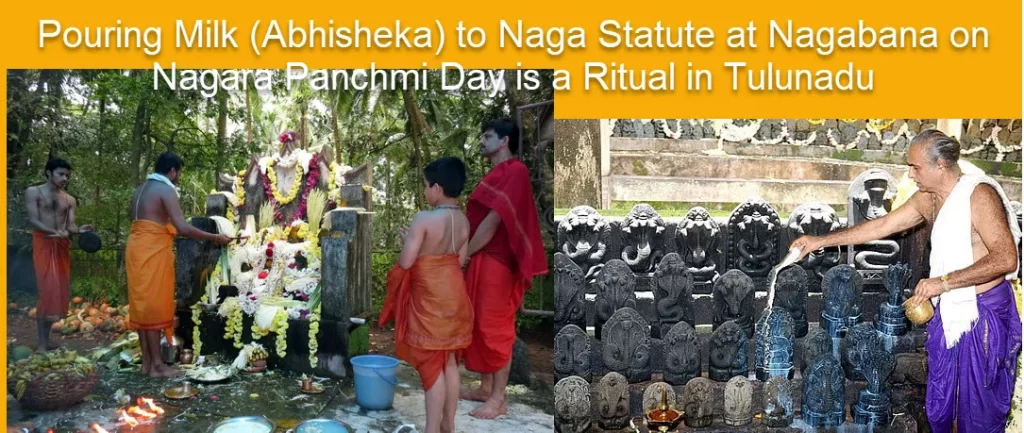
The ritual, centered on the serpent design, continues until early in the morning. A similar ritual is found in Kerala and is known as Sarpam Thullal and Sarpam Kali. All communities of Tulu Nadu revere snakes.
Significance of Nagabanas
Nagabanas or the sacred groves are deemed to be the resting place of snakes. Cutting of trees or defacing the grove is considered as sacrilege. People are wary of the snake-bites and also wanted ecological preservation.
Nagara Panchami
Naga Panchami is a traditional worship of snakes or serpents observed by Hindus throughout India, Nepal and other countries where Hindu adherents live. The worship is offered on the fifth day of the bright half of the Lunar month of Shravana (July/August), according to the Hindu calendar. People make snakes out of clay, giving them different forms and colours. These serpent models are placed on a dais and offered milk. In some parts of Maharashtra and Karnataka, there are permanent temples of Serpent-Gods and special pooja is performed with pomp and grandeur. There is special importance of snake-charmers too on this day, as they are offered milk and money. Digging of the earth is strictly forbidden on this day. In West Bengal, the Hindus worship ‘Devi Manasha’ with ‘Ashta Naag’, the Snake-Goddess on this tithi.
Nagara Panchami: Significance And Rituals
Nag Panchami Vrat or fast is observed on the Panchami of the bright half of the month of Shravan. According to Garuda Purana, paintings of ‘Nag’ should be drawn on either side of the entrance (of the home) and worshipped. This is also known as ‘Bhitti Chitre Nag Puja’. Women offer food, laddoos and kheer (a typical dish made with a mixture of rice, milk and sugar) to Brahmins. Similar food is also offered to snakes and snake charmers.
If you want to conduct a Nagara Panchami puja, adhering to all the correct rituals, Get Online Puja Consultation.
The Story Behind The Nagara Panchami Festival
There are many stories behind the observance of Nag Panchami. The story mentioned below may interest you.
Once upon a time, there lived a peasant who had two sons and one daughter. One day, while the peasant was ploughing the field, the plough ran over three baby snakes, eventually killing them. On seeing the death of her sons, the mother serpent lamented her sons’ death and decided to take revenge on the peasant. In the middle of the night, when the peasant and his family were asleep, the mother-serpent entered their house and bit the peasant, his wife and two sons. As a result, all of them died except the daughter.
Next morning the mother-serpent again entered the house to kill the peasant’s daughter. She was very intelligent and hence, to propitiate the mother-snake offered her a bowlful of milk, and with folded hands requested her to forgive her father for the death of her beloved sons. She welcomed the serpent and asked for it to forgive her parents. Mother serpent was very pleased by this gesture and brought back to life the peasant, his wife and two sons whom she bit the previous night. Also, mother serpents gave blessings with a promise that on Shravan Shukla Panchami, the women who will worship a snake shall be protected for seven generations.
That was the day of Nag Panchami, and since then snakes are worshipped to avoid snake bites. This tithi is also celebrated as ‘Kalki Jayanti’. On this special day, people influenced by Kaal Sarpa Dosha of Rahu and Ketu should also worship ‘Ashta Nag’ with ‘Sarpa Sutra’ and ‘Nag Gayatri’ to get rid of ill effects of this Dosha.
Significance Of Milk On Nag Panchami Festival
One crucial story that stands relevant about feeding milk to snakes goes back to the samudra manthan. In the quest of finding amrit by devas and asuras, a deadly poison named alakatoom erupted from the ocean. It has the power to wipe out the entire universe. Lord Shiva drank the poison for saving the universe. While drinking, some droplets fell on earth, which were consumed by his snakes. The Devtas performed the Ganga Abhishek on Neelkantha and snakes for calming the effect of poison. Hence, the nag panchami is the representation of the whole mythological process.
Nagara Panchami Patholi with Turmeric Leaves
From mid-June to September, fresh turmeric leaves are in peak season in Goa and Coastal Karnataka (Mangalore, Udupi) region of India. Turmeric leaves are popularly known as haldi pana in Konkani, arasina yele in Kannada, and this dish (patholi) is known as sihi kadubu in Kannada. The dish can also be prepared using Banana tree leaves or leaves of the Frangipani (Champe/Champa) tree.
Patholi or Patholi or Patoleo or Arishina Ele Kadubu or Panpathle(In Tulu) is a steamed Indian dish where the rice rolls or dumplings are filled with jaggery and coconut mixture. The highlight or the unique aroma of this dish comes from steaming it in turmeric leaves. This dish is especially made during Nagara Pachmai time in Coastal Karnataka. Naga Panchami (Nagara Panchami) and Gowri Ganesh Chaturthi (Vinayaka chavithi) festivals are incomplete without Patholi in Mangalore and Udupi region. You prepare multiple recipes during GANESH CHATURTHI but nothing can beat the fragrance of patholi steamed in turmeric leaves. It is just heavenl
This dish or dumpling is vegan and vegetarian, gluten-free, oil-free, and dairy-free. One of the healthy desserts that you can try during the festive season, as no oil or butter or sugar, or flour is used in the recipe. Jaggery is used as a sweetener instead of sugar.
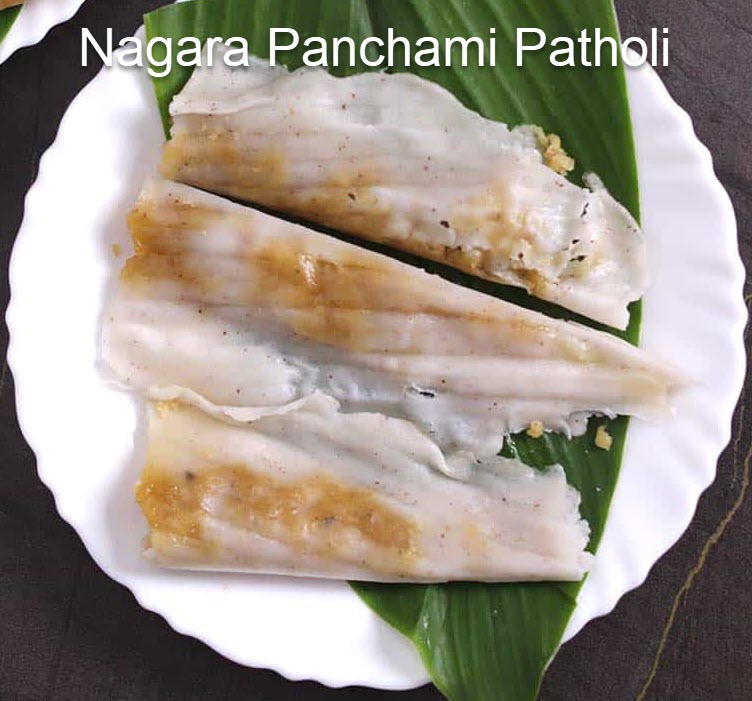
Nagamandlala Kannada Movie
Nagamandala is a 1997 Indian Kannada-language drama film, directed by T. S. Nagabharana based on a play of same name by Girish Karnad.It was produced by Srihari L. Khoday and the music was scored by C. Aswath. It is an adaptation of a 1988 play by Karnad with the same name which is based on a local folk tale and ritual. It stars Prakash Raj and Vijayalakshmi in the lead roles. The film depicts a romantic plot between a woman and a snake in the disguise of her uncaring husband.
The film, upon release, went on to win many prestigious awards for its content and screen adaptation. The soundtrack, consisting of 15 tracks, tuned by C. Ashwath became very popular for the folksy touch. Vijayalakshmi won Filmfare Award for Best Actress – Kannada for her performance in this film.
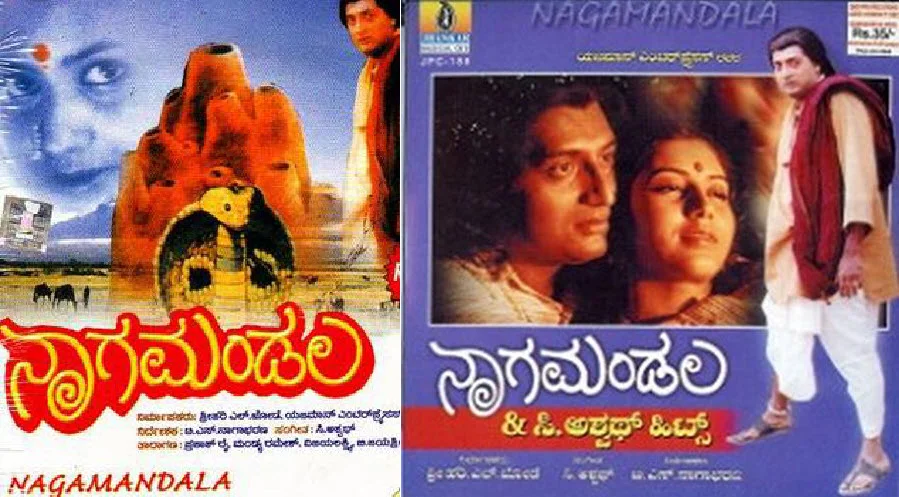
The movie was selected for Indian Panorama at International Film Festival of India in 1997.
Movie Story
The movie begins with Kurudamma (blind woman) and her son Kappanna visiting her nephew for a Devi festival. There she sees her beautiful daughter Rani. Her nephew asks her to find a suitable match for Rani. Kurudamma feels Appanna as a perfect match for Rani and pesters him regularly for consenting to marry Rani. Finally Appanna gives in and marries Rani.
On their first night at Rani’s maternal home, a timid Rani is taken aback by lusty & overbearing husband, she sleeps in a corner of the room. They return to Appanna’s village where Rani confides her fear to Kurudamma who convinces Rani to win him over by teasing & playfulness. However, that night she is again overcome by fear and locks herself in the pooja room. Appanna scolds her and leaves the house and heads to Chelvi, a prostitute’s house.
Next day, Kurudamma comes there and realizes that Rani is locked. She gives Rani a small root & asks her to mix it with milk and give it to Appanna so that the couple can consummate their marriage. Next day she does so but Appanna falls unconscious only to regain consciousness after a minute and leaves the house as usual. Again Kurudamma comes there and learns of Rani’s failure and gives her a bigger root this time.
Rani tries to drug the milk, but it catches fire and Appanna arrives home at the same time and goes to bathe as usual. A terrified Rani pours it under a tree which drains into an anthill under the tree. On seeing this, Rani is further scared and returns home. Apparently the snake would have consumed the milk and it comes to her bed that night.The snake then assumes the form of Appanna. It then talks her out and consoles her. It sleeps her on his lap and wins over her affection. The next morning the snake is gone & the real Appanna comes in and is surprised to see a cheerful Rani and scolds her. Rani is perplexed by this. At night, a melancholic Rani is waiting near the door for Appanna and the snake again arrives in Appanna’s form. They consummate their union that night. Next morning, the snake is gone as usual & Appanna arrives only to see a half naked Rani lying in bed with all the clothes & flowers lying around, as if after the marriage night. A suspicious Appanna tells about this in his gym. His teacher volunteers to keep a watch at Appanna’s house that night and is killed by the snake which used to take the form of Appanna while he was doing so.
The next day Appanna and his friends are shocked to see their teacher dead. Next morning after the gym session Appanna arrives home and sees Rani lying half naked in bed. This continues for a few days. One night he decides to keep watch of the door himself. That night the snake waits for him to leave. A frustrated Appanna upon waiting too long leaves to Chelvi’s house. Meanwhile, Rani realizes that she is pregnant. The snake comes back to Rani in Appanna’s form and learns of her pregnancy and asks her to keep it a secret and not talk about it in the morning.
After a couple of days, Kurudamma and Kappanna learns of the pregnancy and rush to the gym to congratulate Appanna. A furious Appanna beats Rani asking her who the father is, also denies having slept with Rani. The elders pacify him and decides to call for a panchayat session that evening to investigate. During the panchayat investigation, some people in the crowd demand a severe test – ‘Naga divya’ – holding a snake in the hand and swearing by the truth. Rani agrees to it and picks up a snake in the anthill.This snake happens to be the very snake which impregnated Rani. Thus Rani escapes unhurt and the village adores her.
Meanwhile, Appanna is frustrated and goes away to Chelvi.That night the snake appears as Appanna and is confronted by Rani in her house. Meanwhile, the real Appanna arrives there unseen by Rani. The snake realizes this and sends Rani to fetch milk. It takes its form and slithers away through the window. Appanna sees this and realizes that the snake had taken his form and was sleeping with Rani all these days. He goes to the anthill where the snake appears in Appanna’s form and a fight ensues. When the snake is about to kill Appanna, the former realizes that Rani’s love has eliminated all the poison in him and spares the latter. Appanna however beats the snake and throws him into the fire. The snake assumes his real form and dies.
After a few months, Appanna is a changed man who loves his wife. He is shown taking his heavily pregnant wife to a fair.
Go to Tulu News Page to read more about Tulu Nadu News, Events etc.
Go to Our Partner Website to book Self Drive Cars to drive in Mangalore, Udupi and Kasargod

